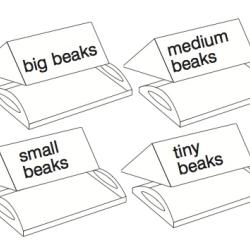Source Institutions
Source Institutions
Add to list Go to activity
Activity link broken? See if it's at the internet archive

In this activity, leaners will observe the process of natural selection on a population of birds called 'Springbeaks' over four seasons of breeding on an isolated environment called 'Clippy Island.' Learners will simulate feeding in a timed exercise to illustrate how a limited food supply and the introduction of genetic variants can lead to natural selection and adaptation. Learners will examine whether or not beak size affects the ability of a Springbeak to gather food and how this variation can affect successive generations in the population. This activity is designed for large groups of 30 learners but can work for smaller groups of at least 16 learners.
- 10 to 30 minutes
- 45 to 60 minutes
- $10 - $20 per group of students
- Ages 11 - adult
- Activity, Experiment/Lab Activity, Lesson/Lesson Plan, Simulation
- English
Quick Guide
Materials List (per group of students)
- 20 large binder clips
- 20 medium binder clips
- 20 small binder clips
- 20 tiny binder clips
- 1 large Bulldog clip
- 4 plastic trays
- 30 plastic cups
- 2 bags of dried white beans
- 1 bad of dried black beans
- 1 bad of dried red beans
- 1 stop watch
- 2 large foam sheets
- 2 large tables
- 1 small table
- 30 copies student worksheets
- Population Record Chart (Table 3.4 in the resource pack) on to a flip chart
- “North Island" and "South Island” signs
- Copies of “Calorie values of food on Clippy Island” (Table 3.1)
- Copies of "The Thresehold for Survival: Food Requirements" (Table 3.3)
- Copies of "The Feeding Rules" (Table 3.2)
- “big beaks”, “medium beaks”, “small beaks”, “tiny beaks” signs
Subjects
-
Life Sciences
-
Diversity of Life
- Animals
-
Ecology
- Ecosystems
- Populations
-
Evolution
- Mechanisms of Evolution
-
Diversity of Life
Informal Categories
- Animals
- Nature and Environment
Audience
To use this activity, learners need to:
- see
- see color
- read
- be mobile
- touch
Learning styles supported:
- Involves hands-on or lab activities
Other
Components that are part of this resource:
Includes alignment to state and/or national standards:
This resource is part of:
Access Rights:
- Free access
By:
- The University of Manchester; The Manchester Museum; Furness, Lauren ; Sutherland, Louise ; Chalk, Hannah ; Bulleid, Dr. Susan ; Bamford, Dr. Amanda ; McGhie, Henry
Rights:
- All rights reserved, Biotechnology and Biological Sciences Research Council,
